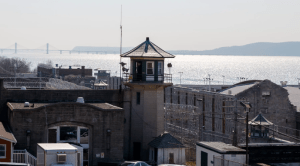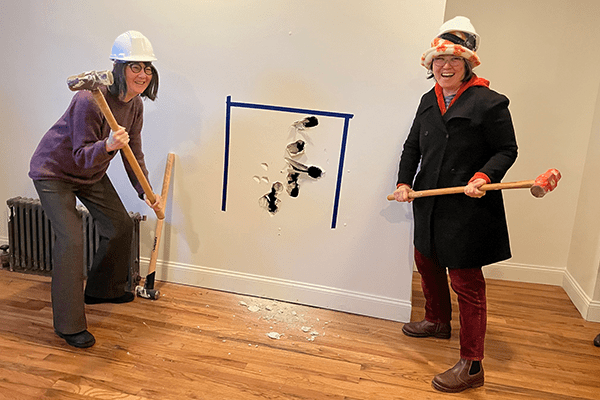|
RCBJ-Audible (Listen For Free)
|
Long Planned Mission To Create Sing Sing Museum Will Focus On Contemporary Issues In The Penal System
By Tina Traster
A project three decades in the making symbolically birthed this week in Ossining with the exuberant swing of sledgehammers smashing through a wall at 65 Central Avenue.
Welcome to the future home of the Sing Sing Prison Museum.
The Board of Trustees of the Sing Sing Prison Museum, along with local elected and former state officials, as well as the owners of the 1865 Olive House, a former Opera House, gathered to mark the event with a “wall-breaking,” words of exhilaration, and champagne.
“This is an interesting chapter,” in Sing Sing’s history, said Brent Glass, the museum’s Executive Director. Glass is a museum consultant, and a former director of the National Museum of American History at Smithsonian in Washington, D.C. He told attendees the “first story” about the idea for a Sing Sing museum was written up in The New York Times in 1987.
If timing is everything, the Sing Sing Prison Museum has hit the jackpot: the release of the 2025 Oscar-nominated film of the eponymous prison name that humanizes prisoners through the dramatic arts, and the 200th anniversary of the prison’s founding.
The museum is expected to open in the fall.
“Almost every chapter in (prison) history has a few pages written in Sing Sing,” said Glass, who said the mission for the project is to shed light on the history of the prison, to explore prison reform, and ultimately to pose the question: “Why do we have prisons?”
Sing Sing Prison Museum will initially occupy 1,500 square feet of gallery space on the first floor of the 13,000-square-foot 1865 Olive House, the former Opera House, situated .7 miles from the Sing Sing Correctional Facility on Hunter Street. The building, owned by the Fan sisters and their family since the 1940s, is set to become a cultural center at the heart of Ossining. The building is also home to Hudson Valley Books for Humanity.
“The criminal justice system has its ups and downs,” said Jane Friedman, a museum board member. “This project is part of its ups.”
Sing Sing Prison Museum’s assistant director Amy Hufnagel said the project is less about prison – and more about prison reform.
“We’re not going to focus on the electric chair,” she said. “We’re focused on prison reform. This will be a place to discuss the penal system, its corrections, and reform.”
 Museum officials have attracted partners like Hudson Link for Higher Education, which works with accredited colleges to provide education, life skills and reentry to incarcerated people. The program provides post-secondary educational opportunities for incarcerated students enrolled in programs at six correctional facilities in the greater New York area.
Museum officials have attracted partners like Hudson Link for Higher Education, which works with accredited colleges to provide education, life skills and reentry to incarcerated people. The program provides post-secondary educational opportunities for incarcerated students enrolled in programs at six correctional facilities in the greater New York area.
Board members with criminal justice experience include Anthony Czarnecki, a former Chief of Staff at the Westchester County Correction Department for 25 years, and president of The Chartwell Group USA – a criminal justice consulting firm. Also, Brian Fischer, who served as Commissioner of the New York State Department of Corrections and Community Supervision from 2007 to 2013. Before that, he was the Superintendent of Sing Sing Correctional Facility from 2000 to 2007.
And straight from Hollywood – riding the buzz surrounding the well-received Sing Sing film — is Jon-Adrian Velazquez (“JJ” Velazquez), an American legal reform activist and actor who was wrongfully convicted of a 1998 murder of a retired police officer. He was serving a 25-years-to-life sentence at maximum security Sing-Sing prison before being granted clemency and released in 2021. He is Co-founder and Executive Director of Voices from Within in New York, and nationally, Program Director at the Frederick Douglass Project for Justice. He will act as a museum consultant.
Velazquez, who lives in White Plains but spent most of his post-prison years in the Village of West Haverstraw, co-stars with the Oscar-nominated Colman Domingo, Paul Raci, and Clarence Maclin in the A24 prison drama Sing Sing that brings to life a group of incarcerated men played by formerly incarcerated actors who find purpose through acting in theater productions.
As a young man in his early 20s, Velazquez struggled to put food on the table for his two babies. He had an early scrape with the law but blames being misidentified for a crime he didn’t commit. Velazquez said he was misidentified in the case because witnesses were presented with hundreds of images of people previously convicted of unrelated crimes.
“Everything I endured is based on the fruit of a poisonous tree,” he said in a phone interview.
Beginning around 2002, Velazquez wrote letters to Dateline NBC producer Dan Slepian, after hearing about another one of Slepian’s documentaries that resulted in getting another conviction overturned. Dateline producers began a decade-long investigation, tracking down and interviewing witnesses and others involved in the case.
In 2013, Velazquez led the formation of “Voices From Within” a comprehensive multimedia education initiative that addresses the epidemic of crime and incarceration directly through voices of incarcerated individuals living with the consequences of their choices, and the victims left in their wake while inside Sing Sing.
On September 9, 2021, after 23 years, 8 months and 7 days of imprisonment, Velazquez was freed from Sing Sing Correctional facility. A year later, President Joe Biden apologized to Velazquez on “behalf of all society” for his wrongful conviction.
Board members of Sing Sing Prison Museum expect to grow into 3,500 square feet of space in the Olive Opera House. They have signed a five-year lease. The organization is using the proceeds from a $1.5 million capital campaign fundraiser to renovate the interior spaces with new mechanicals, plumbing, bathroom, and façade improvements. Construction is slated to take about two years, but Glass said the museum will begin to operate by the fall.
The Board has raised close to $5 million in grants from the Mellon Foundation, American Express, the National Endowment for the Humanities, the American Historical Association to seed its mission. Last month the Lilly Endowment pledged $2.5 million for a program on religion and prisons.
“Religion has always been part of the narrative for Sing Sing,” said Glass.
Glass projects an annual budget for the next four years. $625,000 per year will be drawn from the $4.8 million grant, while the balance will be raised from state grants, foundations and individual donors.
“There is great interest in history, of this place,” said Glass, adding the museum hopes to eventually coordinate tours to the prison to view cell block ruins built in the early 19th century at Sing Sing. But the museum’s mission will focus on contemporary issues.
“We want to ask questions even if we don’t have answers,” said Glass. “Why do we have prisons, are there other options, what can we do to make them more humane while ensuring public safety?”
Brent and the board believe Sing Sing’s location along the banks of the Hudson River, a stone’s throw from Ossining’s Village center, ties the entities together. In the $10 million DRI the Village received in 2021, one of the stated goals was to focus on synergistic projects. Integrating Sing Sing’s lore and the dialogue around prison life and reform with culture and the arts has the potential to stimulate economic growth and put a global focus on a universal issue in the small Hudson River Village.













